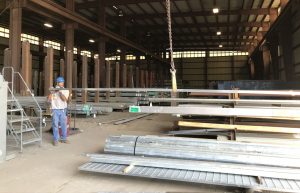
Every year, Berman Bros. processes over 100 million pounds of scrap metal, most of which is then fabricated into new materials through Rubin Iron Works. As part of the metal fabrication, recycled metals are prepared to meet or exceed industry standards for their particular application. These measures are critical to ensuring the safety and reliability of the products in the field. Protecting the quality of their work, Berman Bros. and Rubin Iron Works – both located in Jacksonville, Florida – put their fabrications through multiple industry-leading tests. The top 10 most common metalworking tests are explained below.
- The Spark Test – The spark test is a method of determining the classification of metals. By grinding down a small sample of an unknown metal, the user can observe the color and pattern of the sparks to determine the type of metal. For example, wrought iron will cast sparks with tails that widen at the end, like a leaf; whereas high-speed steel has a faint red spark at the tip.
- Steel Pickling – Steel pickling involves dipping a piece of metal into an acid-based “pickle liquor” to remove a surface layer of impurities, rust and scale. Removing the scale from the surface makes it easier to work the metal. This is done before any cold rolling processes.
- Lamination Test – Lamination tests use an acid application to dissolve the metal in order to determine the presence of laminations or inclusions in the metal sheets. A lamination can result from blisters, seams, foreign material and/or scratches that are not repaired during the rolling process.
- Coupons – Coupons give an estimate of corrosion rates for a material. Coupons are samples of material exposed to corrosive environments for different given periods of time. Comparing coupons to a given metal sample can help establish life expectancy in certain conditions.
- Mill Test Reports (MTR) – An MTR outlines a material’s physical and chemical properties. They confirm that the presented material meets ANSI and ASME standards for application.
- Yield Test – A yield test is a strength test that determines the point at which the material will “give”, changing form and not returning to its original condition. This test is performed with the application of pressure and measured in PSI.
- Tensile Test – Tensile strength is amount of force needed to break the metal, also measured in PSI. The test is typically performed by gripping the ends of a sample with a reduced mid-section and pulling apart with a machine.
- Elongation – Elongation refers to the degree at which a material may be bent, stretched, or otherwise altered before it breaks. Elongation measurements fall at a point between a metal’s yield strength and tensile strength.
- Ultrasonic Tests – Ultrasonic tests use high-frequency sound waves to find hidden flaws, cracks or defects in metal parts and materials. They can also be used to determine thickness. The three basic methods are pulse echo, through transmission, and resonance.
- Brinell Hardness Tests – In a Brinell test, a dense steel ball is pressed into the material. The diameter of the mark left in the material is measured and assigned a Brinell Hardness Number. The higher the number, the harder the material.


